Tibouchinas – Stunning Floral Knockouts
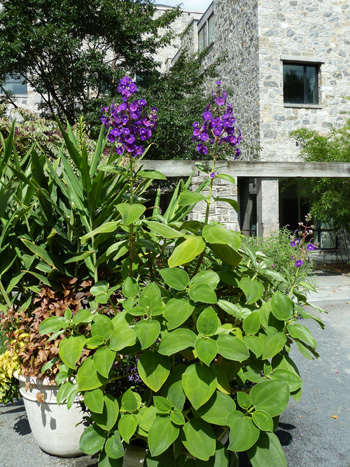 As autumn marches forward and winter is fast approaching, one can’t help contemplating next year’s garden. Part of that contemplation includes reflecting on successes as well as areas for change and alteration. October and November bring the deconstruction of summer containers. As rhizomes and bulbs are tucked in the basement and cuttings begin rooting in the propagation greenhouse, I take this time to recall which containers worked and which didn’t. Part of that evaluation includes recalling which plants attracted the passerby’s attention. One such plant, perhaps that which has generated the greatest comment and question this season, was tibouchina.
As autumn marches forward and winter is fast approaching, one can’t help contemplating next year’s garden. Part of that contemplation includes reflecting on successes as well as areas for change and alteration. October and November bring the deconstruction of summer containers. As rhizomes and bulbs are tucked in the basement and cuttings begin rooting in the propagation greenhouse, I take this time to recall which containers worked and which didn’t. Part of that evaluation includes recalling which plants attracted the passerby’s attention. One such plant, perhaps that which has generated the greatest comment and question this season, was tibouchina.
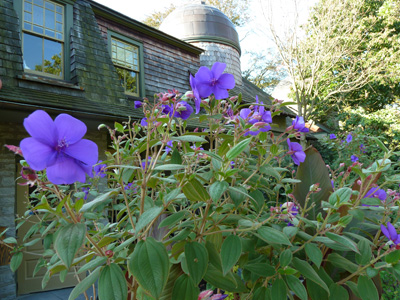
Tibouchina urvelliana blooming in front of the Scott Arboretum offices. photo credit: J. Coceano
Native to Brazil, tibouchina, also known as the princess flower and purple glory bush, has naturalized throughout much of Central America and northern South America. This woody shrub can also be found in frost-free areas of the United States and thrives in full sun, but can tolerate some afternoon shade, especially if planted in a southern exposure or subjected to reflective heat. Provide consistent moisture. Sources recommend fertilizing after each flush of bloom with an acid-lover formula.
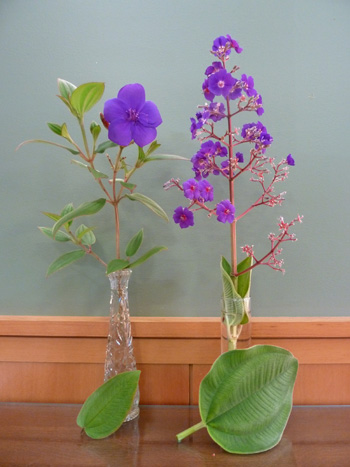
Comparison of Tibouchina urvilleana (Left) and T. grandifolia (Right). photo credit:J. Coceano
Two species of tibouchina are grown at the Scott Arboretum. Tibouchina urvilleana creates a rounded or vase shape growing upwards of 10-20 feet at maturity. The plant responds well to pruning and can easily be kept at a manageable size. Leaves are 2-6 inches in length and covered in soft, downy hairs. Vibrant five-petaled purple blossoms, 3-5 inches wide, flower throughout the growing season.
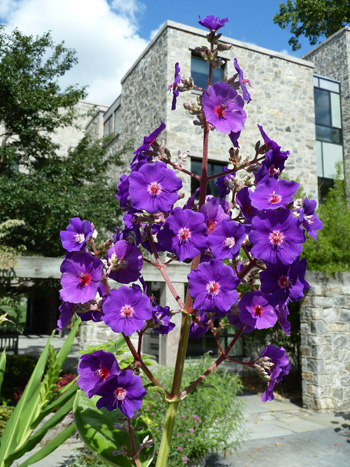
The foot-long flower spikes of Tibouchina grandifolia. photo credit: J. Coceano
Tibouchina grandifolia is similar to its relative but with a few variations. Flowers, in the same shade of purple with fuchsia throats, are borne on foot-long spikes. Flowering typically begins in August. It may take a growing season or two for the species to reach flowering size. Even when not in flower, the plant is a show stopper. Large, velvety leaves up to 10 inches in diameter cover the plant. Visitors and students alike stop to marvel at the blooms. The plant generated the greatest amount of conversation during October’s Perennial Plant Conference.
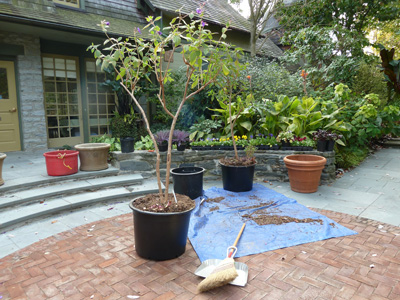
Preparing Tibouchina urvilleana for overwintering in the frost-free basement of Cunningham House. photo credit: J. Coceano
As the threat of frost approaches, plants are dug and placed in plastic containers and stored in the frost-free basement of the Cunningham House where we will check to make sure the soil doesn’t completely dry out. While the plant isn’t actively growing, over and under-watering can result in a lost plant. Both species are stored in a similar manner for overwintering. Soft-wood cuttings are also grown on and provide another method of propagation. Check for availability at the 2012 Unusual Tropical and Annual Sale next March.

Perennial Plant Conference attendees inspired by the blooms of T. grandifolia. photo credit: J. Coceano
It’s never too early to think about next season’s garden. Consider making tibouchinas a part of that garden. Both are excellent in-ground and as container plants and will certainly generate buzz among admirers.





Liane Schleifer
Posted at 07:20h, 04 DecemberAny more detailed tips for overwintering? I cut several back, potted them up and brought them in my full daylight basement which I keep relatively cool. They still have their leaves. I had one tiny one overwinter last year, keeping its few leaves, but it stayed miniscule in the summer. Should I keep them at room temperature or way colder? Dark basement or light? How small should I prune them to prepare them for inside next year? Thanks.
Andrew Bunting
Posted at 14:16h, 06 DecemberLiane,
You could keep it growing as a quasi-houseplant. However, at the Scott Arboretum we let them get slightly frosted and then dig them and plant them in a nursery pot. We put it into a cool basement (cellar-like conditions) with very little light. Any remaining leaves will fall off and it will sit in a somewhat dormant state for the rest of the winter. The soil should be kept on the dry side. We bring the Tibouchina out in mid-May and plant directly into the ground or into an ornamental container.
Andrew Bunting, Curator
Scott Arboretum
Jeremy Hutner
Posted at 09:19h, 25 AprilI purchased some Tibouchina seed this past fall. Any special instructions to get Tibouchina to germinate? I saw a site that said to keep cool first (I’m going to refrigerate for 4 weeks) before sowing seed.
Thanks for any help.
– Jeremy